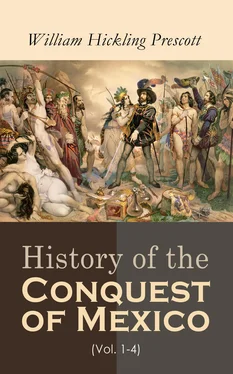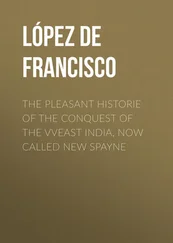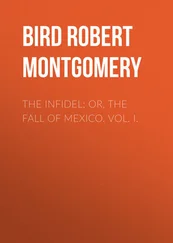[28]The historian speaks, in one page, of the Chichimecs burrowing in caves, or, at best, in cabins of straw, and, in the next, talks gravely of their señoras , infantas , and caballeros !{*} Ibid., cap. 9, et seq.—Veytia, Hist. antig., lib. 2, cap. 1-10.—Camargo, Historia de Tlascala, MS.
[29]Ixtlilxochitl, Hist. Chich., MS., cap. 9-20.—Veytia, Hist. antig., lib. 2, cap. 29-54.
[30][Some recent writers have contended that Mexico must have been peopled originally by migrations from the South. Aztec names and communities, and traces of Toltec settlements long anterior to the occupation of Anahuac by the same people, are found in several parts of Central America. The most primitive traditions, as well as the remains of the earliest civilization, belong also to the same quarter. This latter fact, however, is considered by Orozco y Berra as itself an evidence of the migrations having been from the North, the first comers having been naturally attracted southward by a warmer climate and more fertile soil, or pushed onward in this direction by successive invasions from behind. Contradictory inferences have in like manner been drawn from the existence of Aztec remains and settlements in New Mexico and Arizona. All that can be said with confidence is that neither of the opposing theories rests on a secure and sufficient basis.—K.]
[31]These were the Colhuans, not Acolhuans, with whom Humboldt, and most writers since, have confounded them.{*} See his Essai politique, tom. i. p. 414; ii. p. 37.
{*} [Humboldt, strictly speaking, has not confounded the Colhuans with the Acolhuans, but has written, in the places cited, the latter name for the former. “Letzterer Name,” says Buschmann, “ist der erstere mit dem Zusatz von atl Wasser,—Wasser Colhuer.” (Uber die aztekischen Ortsnamen, S. 690.) Yet the two tribes, according to the same authority, were entirely distinct, one alone—though which, he is unable to determine—being of the Nahuatlac race. Orozco y Berra, however, makes them both of this stock, the Acolhuans being one of the main branches, the Colhuans merely the descendants of the Toltec remnant in Anahuac.—K.]
[32][This is not quite correct, since the form used in the letters of Cortés and other early documents is Temixtitan , which is explained as a corruption of Tenochtitlan. The letters x and ch are convertible, and have the same sound,—that of the English sh . Mexico is Mexitl with the place-designation co , tl final being dropped before an affix.—K.]
[33]Clavigero gives good reasons for preferring the etymology of Mexico above noticed, to various others. (See his Stor. del Messico, tom. i. p. 168, nota.) The name Tenochtitlan signifies tunal (a cactus) on a stone . Esplicacion de la Col. de Mendoza, apud Antiq. of Mexico, vol. iv.
[34]“Datur hæc venia antiquitati,” says Livy, “ut, miscendo humana divinis, primordia urbium augustiora faciat.” Hist. Præf.—See, for the above paragraph, Col. de Mendoza, plate 1, apud Antiq. of Mexico, vol. i.,—Ixtlilxochitl, Hist. Chich., MS., cap. 10,—Toribio, Historia de los Indios, MS., Parte 3, cap. 8,—Veytia, Hist. antig., lib. 2, cap. 15.—Clavigero, after a laborious examination, assigns the following dates to some of the prominent events noticed in the text. No two authorities agree on them; and this is not strange, considering that Clavigero—the most inquisitive of all—does not always agree with himself. (Compare his dates for the coming of the Acolhuans, tom. i. p. 147, and tom. iv., dissert. 2:)—
|
A. D. |
| The Toltecs arrived in Anahuac |
648 |
| They abandoned the country |
1051 |
| The Chichimecs arrived |
1170 |
| The Acolhuans arrived about |
1200 |
| The Mexicans reached Tula |
1196 |
| They founded Mexico |
1325 |
See his dissert. 2, sec. 12. In the last date, the one of most importance, he is confirmed by the learned Veytia, who differs from him in all the others. Hist. antig., lib. 2, cap. 15.
[35][In a somewhat similar way was founded the Italian Venice. It was the fear of death at the hands of Attila and his Huns that caused the peopling of the islands among the lagoons of the Adriatic. It was the easy subsistence the lagoons afforded that caused the steady growth of the Italian village.—M.]
[36][This confederacy occupied one of the strongest defensive positions ever held by Indians. It gradually extended its sway over a large part of the Mexican territory. This “sway,” however, as Fiske points out, was not a military occupation of the country. It was a “system of plunder enforced by terror.”—M.]
[37]The loyal Tezcucan chronicler claims the supreme dignity for his own sovereign, if not the greatest share of the spoil, by this imperial compact. (Hist. Chich., cap. 32.) Torquemada, on the other hand, claims one-half of all the conquered lands for Mexico. (Monarch. Ind., lib. 2, cap. 40.) All agree in assigning only one-fifth to Tlacopan; and Veytia (Hist. antig., lib. 3, cap. 3) and Zurita (Rapport sur les différentes Classes de Chefs de la Nouvelle-Espagne, trad. de Ternaux (Paris, 1840), p. 11), both very competent critics, acquiesce in an equal division between the two principal states in the confederacy. An ode, still extant, of Nezahualcoyotl, in its Castilian version, bears testimony to the singular union of the three powers:
“solo se acordarán en las Naciones
lo bien que gobernáron
las tres Cabezas que el Imperio honráron.” Cantares del Emperador
[38]See the plans of the ancient and modern capital, in Bullock’s “Mexico,” first edition. The original of the ancient map was obtained by that traveller from the collection of the unfortunate Boturini; if, as seems probable, it is the one indicated on page 13 of his Catalogue, I find no warrant for Mr. Bullock’s statement that it was the one prepared for Cortés by the order of Montezuma.
[39][The first man chosen to be the chief of men (tlacatecuhtli), or superior officer of the confederacy, was Acamapichtli. His election took place in 1375, and he is sometimes called by European writers the “founder of the confederacy.” His name, translated, was “Handful of Reeds.” The succession of “chiefs of men” was as follows:
| 1. |
Acamapichtli (Handful of Reeds) |
1375 |
| 2. |
Huitzilihuitl (Humming Bird) |
1403 |
| 3. |
Chimalpopoca (Smoking Shield) |
1414 |
| 4. |
Izcoatzin (Obsidian Snake) |
1427 |
| 5. |
Montezuma I (Angry Chief) |
1436 |
| 6. |
Axayacatl (Face in the Water) |
1464 |
| 7. |
Tizoc (Wounded Leg) |
1477 |
| 8. |
Ahuitzotl (Water Rat) |
1486 |
| 9. |
Montezuma II |
1502 |
| 10. |
Cuitlahuatzin |
1520 |
| 11. |
Guatemotzin |
1520 |
M.]
[40]Clavigero, Stor. del Messico, tom. i. lib. 2.—Torquemada, Monarch. Ind., tom. i. lib. 2.—Boturini, Idea, p. 146.—Col. of Mendoza, Part 1, and Codex Telleriano-Remensis, apud Antiq. of Mexico, vols. i., vi.—Machiavelli has noticed it as one great cause of the military successes of the Romans, “that they associated themselves, in their wars, with other states, as the principal,” and expresses his astonishment that a similar policy should not have been adopted by ambitious republics in later times. (See his Discorsi sopra T. Livio, lib. 2, cap. 4, apud Opere (Geneva, 1798).) This, as we have seen above, was the very course pursued by the Mexicans.
Читать дальше












